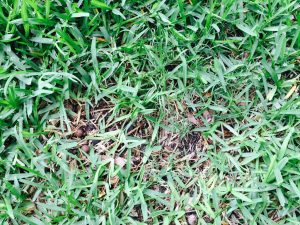 Take-All Root Rot (Aka TARR) is a fungal disease that mainly attacks St. Augustine grass. When it affects Bermuda grass, it is known as Bermuda decline. The disease will make lawns weak and brown with dead patches where the fungus is or has attacked. It can be fatal if not addressed.
Take-All Root Rot (Aka TARR) is a fungal disease that mainly attacks St. Augustine grass. When it affects Bermuda grass, it is known as Bermuda decline. The disease will make lawns weak and brown with dead patches where the fungus is or has attacked. It can be fatal if not addressed.
In the Bible, sulfur is called “brimstone”. Sulfur is a chemical element with atomic number 16 and the symbol “S”. In the lawn and garden world, it is used as an insect repellent, a fungicide and to lower the pH of alkaline soil.
That last part is important in the fight against TARR. We live in an area known for black dirt, which is very alkaline. The pH scale runs from 0 – 14. 0 is pure acid and 14 is alkaline. Native soil in our part of Collin County is in the 8 – 9 range and TARR loves alkaline soil. I believe that it is better to prevent an issue than to react to one, so let’s look into preventing TARR by lower the pH of the soil. Sulfur, peat moss, and fertilizers high in sulfur like 16-20-0 (12%s), 28-6-6 (12%s), and ammonium sulfate (21-0-0 w 24%s) will also lower the pH over the years. Remember, this is a process, not an event.
When granulated sulfur is used to lower the pH in a garden, till it in at a rate of 1 to 2 pounds per 100 square feet. The pH change will be complete in 6 to 8 weeks. You can speed up this timeline by using powdered sulfur. This change is temporary and there are so many factors at play that it’s hard to predict how long this change will last. The problem with employing this procedure in the lawn is that you would have to till and that is counterproductive to growing grass. Eliminating the tilling aspect and applying sulfur to the surface should be looked at as a maintenance item, just like fertilizer. Application rates for sulfur are in the 5 – 10 pounds per 1,000sf twice a year.
Using peat moss as a standalone process is also a very effective way to reduce the pH. Application rate is 1 – 2, 3.8cf bales per 1000sf, 1 -2 times per year. The only problem with peat moss is that it is a mess to deal with. This is where a compost spreader that will spread peat moss comes in handy. It just so happens that Wells Brothers rents such a spreader. It requires dry peat moss and some muscle for this compost spreader to work properly. There are a lot of factors at play here but in good conditions, a 3.8cf bag of peat moss will spread from 500 to 800 square feet. You can add compost to peat moss or sulfur for added benefit.
There are also fungicides that are effective treatments for TARR. The two that Wells Brothers offers are Fertilome products. F-Stop is available in liquid and granulated, Liquid Systemic Fungicide is available in quarts and pints. As always read and follow the label directions.





